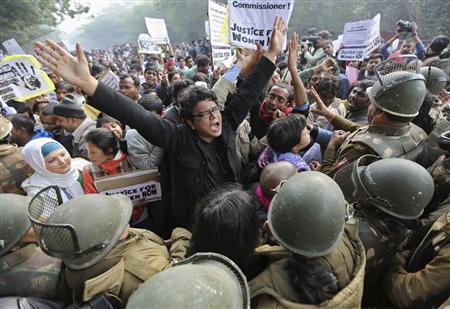When Preeti Joshi heard of the
gang rape of a fellow student, she joined a movement of thousands of
outraged young Indians who have taken to the streets of New Delhi almost
every day protesting for justice and security for women.
Beaten and raped by five men and a teenager on a moving
bus in the capital on December 16, the 23-year-old student died from
her injuries on Saturday, her plight shaking the conscience of many
urban middle class Indians who consider gender rights as important as
poverty alleviation.
India's politicians, seen as out of touch with the
aspirations of the urban middle class, have been caught off guard by the
protests. For the first time, they head into national elections due by
May 2014 with women's rights as an issue.
Even so, the issue is unlikely to be the defining one.
Massive rural vote banks have been untouched by demands
for gender equality and the fury across India's cities may fade, just
as unprecedented protests in New Delhi over corruption did 16 months
ago.
"Rural populations in this country are more concerned
about basics such as development," said Ranjana Kumari, director of the
Centre for Social Research, a Delhi-based gender rights think-tank.
This jars with what urban protesters like Joshi want.
"I thought we lived in the world's biggest democracy
where our voices counted and meant something. Politicians need to see
that we need more than bijli, sadak, paani (power, roads, water)," said
Joshi, 21, a student of social sciences at Delhi's Jawaharlal Nehru
University.
Sexual violence against women in largely patriarchal
India is widespread, say gender rights activists, and crimes such as
rape, dowry murders, acid attacks, honor killings, child marriages and
human trafficking are common.
But the savagery of this crime - where the victim was
raped for an hour and tortured with an iron rod which did serious damage
to her internal organs - has stirred national debate and put gender
issues on the political agenda.
The victim's name has not been released. Her alleged
attackers have been detained in connection with the crime and police are
likely to press murder charges this week. Prosecutors are expected to
seek a death sentence for the adults.
"The girl's assault and death were the lancing of
wounds that have festered for years. Women had shut up for fear of
social pressures but now there's a collective voice to demand change,"
says Renuka Chowdhury, a parliamentarian and spokeswoman for the main
ruling Congress Party and former minister for women and child
development.
"This is for the first time, perhaps, that politicians
are seeing women as a constituency. People will slowly learn to accept
that a woman's vote will matter in times to come."
GOVERNMENT UNDER FIRE
The government's initial response to the attack drew criticism.
It angered protesters by trying to throttle the largely
peaceful demonstrations by imposing emergency policing laws,
barricading roads and closing down underground train stations.
And it was a week before Prime Minister Manmohan Singh
made a statement, in which he appealed for calm and promised to create a
safer environment for women.
"We will examine without delay not only the responses
to this terrible crime but also all aspects concerning the safety of
women and children and punishment to those who commit these monstrous
crimes," Singh said in a rare televised address to the nation on
December 24.
One senior government official who did not want to be
identified said Singh had been waiting for the home minister and the
Delhi authorities to deal with the issue first.
Many protesters have also expressed disappointment at
the low profile of younger politicians such as Rahul Gandhi, seen as the
Congress Party's prime ministerial candidate in the 2014 elections and
who could have helped bridge the gap between the demonstrators and the
political establishment.
His first comment, extending sympathy to the victim's
family and urging respect for women, came after the student had died.
Analysts said the slow and bumbling response from the
elite illustrated how India's politicians are out of touch with the
demands of the country's urban youth.
"Whatever the trigger, one thing is absolutely clear:
India's political class has been left bewildered by the street protests
involving large numbers of mostly apolitical and leaderless
individuals," wrote political pundit Swapan Dasgupta in the Times of
India on Sunday.
PATRIARCHAL POWER
But gender rights are unlikely to make a significant
dent in India's elections. Similar street protests in August 2011 over
corruption fizzled due to the inability of organizers to maintain public
pressure and keep the media interested.
Despite gender sensitive laws being in place for
decades, including those outlawing practices such as dowries and child
marriage, they have been poorly implemented largely due to a lack of
political will, activists say.
Many of India's legislators are elderly men who rely on
the support of the rural masses, where deep-rooted patriarchal
attitudes mean blame is often first assigned to the victims of sex
attacks.
One of the most powerful female figures in Indian
history is former Prime Minister Indira Gandhi. Her daughter-in-law,
Sonia Gandhi, mother of Rahul, heads the Congress Party and there are
also more than one million female politicians in village councils.
Yet only 11 percent of seats in India's lower and upper
houses of parliament are held by women, ranking it 110th out of 145
countries, below less developed nations such as Niger and Pakistan, says
the Inter-Parliamentary Union, a Geneva-based union of national
parliaments.
For almost 18 years, moves to give women greater power
at the national and state level through the Women's Reservation Bill,
which would guarantee 33 percent of seats to women at those levels, have
been blocked by male legislators.
"Political parties give tickets for fighting elections
on the basis of electoral calculations. How many women are there in
Indian politics who can get elected time after time? Very few, right?"
said Nirmala Sitharaman, spokeswoman for the main opposition Bharatiya
Janata Party.
Gender rights activists also point out that political
parties have allowed male legislators who themselves face rape charges
and other crimes against women to represent them.
Six serving state legislators have been charged with
rape, while 36 others including two national parliamentarians have faced
charges of sexual harassment, molestation or assault on a woman before
holding an assembly seat, according to the Association for Democratic
Reforms, a Delhi-based think-tank. (TrustLaw is a global hub for free
legal assistance and news and information on good governance and women's
rights run by the Thomson Reuters Foundation. For more stories, visit
www.trust.org/trustlaw)
















 New
year, new laws. When the ball dropped on midnight, January 1st, we not
only rang in the new year, but also a slew of oddball laws from around
the country.
New
year, new laws. When the ball dropped on midnight, January 1st, we not
only rang in the new year, but also a slew of oddball laws from around
the country.


















